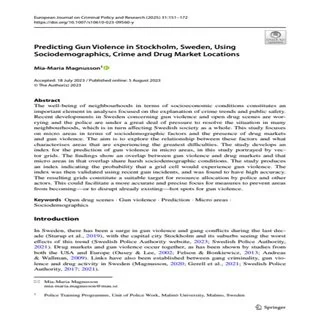By Mia-Maria Magnusson
The well-being of neighbourhoods in terms of socioeconomic conditions constitutes an important element in analyses focused on the explanation of crime trends and public safety. Recent developments in Sweden concerning gun violence and open drug scenes are worrying and the police are under a great deal of pressure to resolve the situation in many neighbourhoods, which is in turn affecting Swedish society as a whole. This study focuses on micro areas in terms of sociodemographic factors and the presence of drug markets and gun violence. The aim is to explore the relationship between these factors and what characterises areas that are experiencing the greatest difficulties. The study develops an index for the prediction of gun violence in micro areas, in this study portrayed by vector grids. The findings show an overlap between gun violence and drug markets and that micro areas in that overlap share harsh sociodemographic conditions. The study produces an index indicating the probability that a grid cell would experience gun violence. The index was then validated using recent gun incidents, and was found to have high accuracy. The resulting grids constitute a suitable target for resource allocation by police and other actors. This could facilitate a more accurate and precise focus for measures to prevent areas from becoming—or to disrupt already existing—hot spots for gun violence.
Eur J Crim Policy Res 31, 151–172 (2025)



